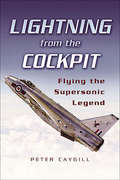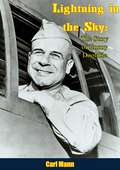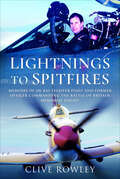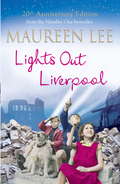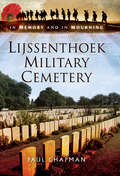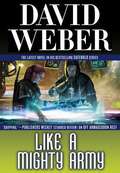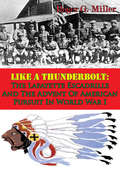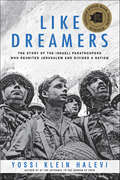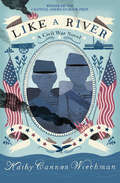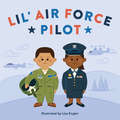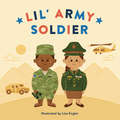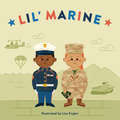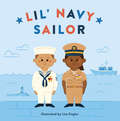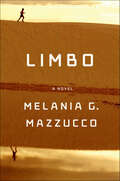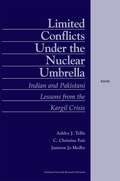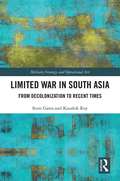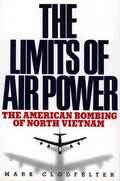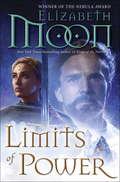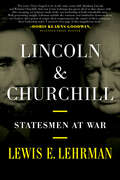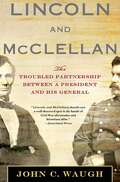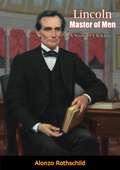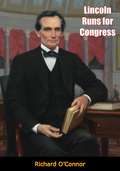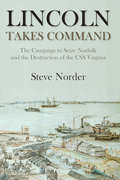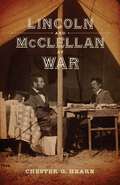- Table View
- List View
Lightning from the Cockpit: Flying the Supesonic Legend (Aviation Ser.)
by Peter CaygillThe English Electric Lightning was the only single-seat supersonic interceptor fighter designed and manufactured in the UK. It saw service with the RAF in the sixties and seventies and gained a worthy reputation for its speed ( in excess of Mach 2 ) and phenomenal rate of climb. It was, however, a not entirely reliable aeroplane and over fifty were lost during its operational career. In this book, the author has gathered together 16 personal accounts of what it was like to fly the Lightning, thrilling stories that convey the immense brute power of the machine and also its many pitfalls. It will enthrall the enormous following the aircraft still enjoys. Two are now flying in South Africa and four are being restored to flight-worthy condition in the UK. To see a Lightning take off and climb vertically until it vanishes into the sky is one of the most spectacular sights in aviation.
Lightning in the Sky: The Story of Jimmy Doolittle
by Carl MannOriginally published in 1943, this is a biography of Jimmy Doolittle (1896-1993), a highly decorated officer in the United States Army Air Corps who pioneered in all phases of aeronautical achievement and commanded the Doolittle Raid on Japan during World War II.He became the first pilot to take the "blind" out of flying and complete the "outside loop", set numerous speed records, and won many racing trophies. Promoted to lieutenant general, he was also awarded the Medal of Honor for his valor and leadership as commander of the Doolittle Raid, a bold long-range retaliatory air raid on the Japanese main islands weeks after the attack on Pearl Harbor. His Tokyo flight is widely regarded as one of the coups of the Second World War.Doolittle also commanded the 12th Air Force over North Africa, the 15th Air Force over the Mediterranean, and the 8th Air Force over Europe.
Lightnings to Spitfires: Memoirs of an RAF Fighter Pilot and Former Officer Commanding the Battle of Britain Memorial Flight
by Clive RowleyA former fighter pilot chronicles his career flying for the Royal Air Force for over four decades in this action-packed memoir. For forty-four years, Clive Rowley flew with the Royal Air Force, and for thirty-one of those years he specialized as an air defense fighter pilot. Such was his love of fast fighter aircraft that, in order to stay flying, he transferred to Specialist Aircrew terms of service, relinquishing any chance of further promotion above his rank of squadron leader. During those years Clive flew Lightnings, Hawks, and Tornado F.3s but, perhaps more intriguingly, for eleven years he flew Hurricanes and Spitfires with the Battle of Britain Memorial Flight (BBMF), the RAF&’s, if not the world&’s most famous &“warbird&” display team, which he ultimately led and commanded. Many readers will have watched him, perhaps unknowingly, as he flew these iconic aircraft, often alongside the Lancaster, at air shows and large-scale commemorations around the UK and Europe. During the Cold War, Clive flew the BAC Lightning from Gütersloh in Germany and in the UK, becoming an expert in the art of air combat in the process. Then for sixteen years he flew the Tornado F.3 as the RAF moved into expeditionary operations. Packed with humorous and often hair-raising anecdotes, but also revealing the shock and sorrow he felt at the deaths of friends and colleagues, this book is a highly detailed account of life as a fighter pilot in the RAF in the last three decades of the twentieth century and into the twenty-first. Clive is open about the fears he sometimes felt in this dangerous world and how he allayed them to continue flying for more than four decades. This book is illustrated with wonderful photographs from his time on the front line as well as with the BBMF, many of which have never been published before. If you have ever wondered what it is like to fly supersonic jet fighters, like the Lightning and the Tornado F.3, or iconic &“warbirds,&” such as the Hurricane and Spitfire, Clive Rowley brings you into those cockpits and shares his experiences.
Lights Out Liverpool: (Pearl Street 1)
by Maureen LeeNumber One bestseller Maureen Lee's first novel of the hugely popular Pearl Street series.As Britain stands alone against a monstrous enemy, the inhabitants of Pearl Street, in Liverpool, face hardship and heartbreak with courage and humour.The war touches each of them in a different way: for Annie Poulson, a widow, it means never-ending worry when her twin boys are called up and sent to France; Sheila Reilly's husband, Cal, faces the terror of U-Boat attacks; Eileen Costello is liberated from a bitter, loveless marriage when her husband is sent to Egypt and she goes to work in a munitions factory - and falls in love. And Jessica Fleming, down on her luck, is forced to return to the street she'd hoped never to see again.
Lijssenthoek Military Cemetery (In Memory and in Mourning)
by Paul ChapmanThis is a comprehensive and highly emotive volume, borne of years of intensive research and many trips to the battlefields of the Great War. It seeks to humanise the Lijssenthoek Military Cemetery, to offer the reader a chance to engage with the personal stories of the soldiers whose names have been chiseled there in stone. Poignant stories of camaraderie, tragic twists of fate and noble sacrifice have been collated in an attempt to bring home the reality of war and the true extent of its tragic cost. It is hoped that visitors to the battlefields, whether their relatives are listed within or not, will find their experience enriched by having access to this treasure trove of stories.
Like A Mighty Army (Safehold #7)
by David WeberFor centuries, the world of Safehold, last redoubt of the human race, lay under the unchallenged rule of the Church of God Awaiting. The Church permitted nothing new--no new inventions, no new understandings of the world. What no one knew was that the Church was an elaborate fraud--a high-tech system established by a rebel faction of Safehold's founders, meant to keep humanity hidden from the powerful alien race that had destroyed old Earth. Then awoke Merlyn Athrawes, cybernetic avatar of a warrior a thousand years dead, felled in the war in which Earth was lost. Monk, warrior, counselor to princes and kings, Merlyn has one purpose: to restart the history of the too-long-hidden human race. And now the fight is thoroughly underway. The island empire of Charis has declared its independence from the Church, and with Merlyn's help has vaulted forward into a new age of steam-powered efficiency. Fending off the wounded Church, Charis has drawn more and more of the countries of Safehold to the cause of independence and self-determination. But at a heavy cost in bloodshed and loss--a cost felt by nobody more keenly that Merlyn Athrawes. The wounded Church is regrouping. Its armies and resources are vast. The fight for humanity's future isn't over, and won't be over soon... David Weber's Like a Mighty Army is the hotly anticipated seventh volume in the New York Times bestselling Safehold series.
Like A Thunderbolt: The Lafayette Escadrille And The Advent Of American Pursuit In World War I [Illustrated Edition]
by Roger G. MillerIncludes 29 IllustrationsThe advent of an American squadron, or "escadrille," within the French air force, the Service Aeronautique, had been far from a simple process. French leaders initially held the belief, common at the time, that the war begun in 1914 would be a short one. The potential value of American volunteers fighting for France both for propaganda purposes and for helping bring the power of the New World into the war on the side of the Allies was thus irrelevant at first. By early 1915, however, the French began to accept American volunteers and assign them to escadrilles. In early 1916, the Service Aeronautique united several of these men in an elite chasse unit, which quickly earned an enviable reputation for audacity, bravery, and élan.Success of this unit, the Lafayette Escadrille, had three consequences. First, its existence encouraged a large number of Americans, far more than needed in one escadrille, to volunteer for French aviation. These individuals, identified unofficially as members of a "Lafayette Flying Corps," served in numerous French air units. Second, the publicity surrounding the Lafayette Escadrille contributed favorable press for the Allied cause, strengthened ties between France and the U.S., and ultimately helped prepare the U.S. to participate on the Allied side of the conflict. Third, the existence of a large body of experienced American pilots provided combat veterans for the Air Service of the American Expeditionary Forces (AEF) in France when the U.S. ultimately entered the war. These veterans helped instill in the U.S. Air Service the attitudes and practices of the Service Aeronautique, an infusion especially reflected in two U.S. pursuit squadrons, the 103rd Aero Squadron, made up of Lafayette Escadrille pilots, and the 94th Aero Squadron, the most famous American combat squadron of the war.
Like Dreamers: The Story of the Israeli Paratroopers Who Reunited Jerusalem and Divided a Nation
by Yossi Klein Halevi“Powerful. . . . beautifully written . . . . There is much to admire . . . especially Mr. Halevi’s skill at getting inside the hearts and minds of these seven men” —Ethan Bronner, New York TimesFollowing the lives of seven young members from the 55th Paratroopers Reserve Brigade, the unit responsible for restoring Jewish sovereignty to Jerusalem during the 1967 Six Day War, acclaimed journalist Yossi Klein Halevi reveals how this band of brothers played pivotal roles in shaping Israel’s destiny long after their historic victory. While they worked together to reunite their country in 1967, these men harbored drastically different visions for Israel’s future.One emerges at the forefront of the religious settlement movement, while another is instrumental in the 2005 unilateral withdrawal from Gaza. One becomes a driving force in the growth of Israel’s capitalist economy, while another ardently defends the socialist kibbutzim. One is a leading peace activist, while another helps create an anti-Zionist terror underground in Damascus.Featuring eight pages of black-and-white photos and maps, Like Dreamers is a nuanced, in-depth look at these diverse men and the conflicting beliefs that have helped to define modern Israel and the Middle East.“A beautifully written and sometimes heartbreaking account of these men, their families, and their nation.” —Booklist, starred review“Halevi's book is executed with imagination, narrative drive, and, above all, deep empathy for a wide variety of Israelis, and the result is a must-read for anyone with an interest in contemporary Israel and the Israeli-Palestinian conflict. —Publishers Weekly, starred review“Mr. Halevi’s masterly book brings us into [the] . . . debate and the lives of those who live it.” —Elliott Abrams, Wall Street Journal
Like a River: A Civil War Novel (Highlights Doodlerama#174; Ser.)
by Kathy Cannon WiechmanWhen Leander Jordan and Paul Settles enlist in the Union army, they each carry deep and dangerous secrets. And when they meet in a Union hospital, they begin to discover each other's secrets and form a bond that will prove impossible to break. That bond will give them both the courage to survive the war as well as to recognize the importance of family, loyalty, and love. Kathy Cannon Wiechman's debut novel--told in two voices--powerfully transports readers to the homes, waterways, camps, hospitals, and prisons of the Civil War. An extensive author's note comments on the book's research and includes archival images.
Lil' Air Force Pilot (Mini Military)
by RP KidsCelebrate real-life heroes in the US Air Force with this early introduction board book series to the US military branches.The Mini Military series focuses on introducing young readers to the various branches of the US military. Lil' Air Force Pilot highlights what it's like to be in the US Air Force, focusing on uniforms and flight gear, and introducing toddlers to military vehicles, such as the fighter jets, helicopters, and bombers. Perfect for military families, those with veterans in their family, or for anyone looking to expose their youngest readers to parts of American society, this book and the series is sure to inspire and celebrate our brave service men and women.
Lil' Army Soldier (Mini Military)
by RP KidsCelebrate real-life heroes in the US Army with this early board book introduction to the US military branches.The Mini Military series focuses on introducing young readers to the various branches of the US military. Lil' Army Soldier highlights what it's like to be in the US Army, focusing on uniforms, helmets, and vests, and introducing toddlers to military vehicles, such as the Humvee, helicopter, and tank.Perfect for military families, those with veterans in their family, or for anyone looking to educate their youngest readers about our troops, this book and the series is sure to inspire and celebrate our brave service men and women.
Lil' Marine (Mini Military)
by RP KidsCelebrate real-life heroes in the US Marine Corps with this early introduction board book series to the US military branches. The Mini Military series focuses on introducing young readers to the various branches of the US military. Lil' Marine highlights what it's like to be in the US Marine Corps, focusing on uniforms, bases, and parachutes, and introducing toddlers to military vehicles, such as the amphibious assault vehicles and aircraft. Perfect for military families, those with veterans in their family, or for anyone looking to expose their youngest readers to parts of American society, this book and the series is sure to inspire and celebrate our brave service men and women.
Lil' Navy Sailor (Mini Military)
by RP KidsCelebrate real-life heroes in the US Navy with this early board book introduction to the US military branches.The Mini Military series focuses on introducing young readers to the various branches of the US military. Lil' Navy Sailor highlights what it's like to be part of this special force, focusing on uniforms, radar tracking devices, and other special items, and introducing toddlers to military vehicles.Perfect for military families, those with veterans in their family, or for anyone looking to educate their youngest readers about our troops, this book and the series is sure to inspire and celebrate our brave service men and women.
Limbo: A Novel
by Melania G. MazzuccoA moving but unsentimental examination of one woman's life as she navigates life after warIt's Christmas Eve and twenty-seven-year-old Manuela Paris is returning home to a seaside town outside Rome. Years ago, she left to become a soldier. Then, Manuela was fleeing an unhappy, rebellious adolescence; with anger, determination, and sacrifice she painstakingly built the life she dreamed of as a platoon commander in the Afghan desert. Now, she's fleeing something else entirely: the memory of a bloody attack that left her seriously injured. Her wounds have plunged her into in a very different and no less insidious war: against flashbacks, disillusionment, pain, and victimhood. Numb and adrift, she is startled to life by an encounter with a mysterious stranger, a man without a past who is, like her, suspended in his own private limbo of expectation and hope. Their relationship—confusing, invigorating—forces her to confront her past and the secrets she, and those closest to her, are hiding. In chapters that toggle between Manuela at home, grappling with her new life, and Manuela in Afghanistan, coming to terms with her role as a leader of fighting men and a peacemaker in a country that doesn't seem to want her help, Melania G. Mazzucco limns a story of love and loss, death and resistance in terms both surprising and cathartic. Limbo asks its readers, no less than its protagonist, what it means to be a daughter, a sister, a woman, a citizen, a soldier—or, more simply, a human.
Limited Conflicts Under the Nuclear Umbrella: Indian and Pakistani Lessons from the Kargil Crisis
by C. Christine Fair Jamison Jo Medby Ashley J. TellisThis report examines the views of India and Pakistan on the significance of Pakistan's foray into the Kargil-Dras sector in a limited war that has come to be known as the Kargil conflict. The goal of the analysis is to assess both combatants' perceptions of the crisis, with a view to evaluating the possibilities of future Kargil-like events and the implications of the lessons each country learned for stability in South Asia. The analysis is based almost exclusively on Indian and Pakistani source materials. The Kargil crisis demonstrated that even the presence of nuclear weapons might not appreciably dampen security competition between the region's largest states. However, the question remains of whether or not the Kargil war represents a foretaste of future episodes of attempted nuclear coercion if India and Pakistan believe that their nuclear capabilities provide them the immunity required to prosecute a range of military operations short of all-out war.
Limited War in South Asia: From Decolonization to Recent Times (Military Strategy and Operational Art)
by Kaushik Roy Scott GatesThis book examines the origins, courses and consequences of conventional wars in post-colonial South Asia. Although South Asia has experienced large-scale conventional warfare on several occasions since the end of World War II, there is an almost total neglect of analysis of conventional warfare in the Indian subcontinent. Focusing on China, India and Pakistan, this volume, therefore, takes a unique approach. Regional rivalries between India and Pakistan are linked with global rivalries between the US and USSR (later Russia) and then China, and war is defined in a broader perspective. The book analyses the conduct of land, sea and air warfare, as well as the causes and consequences of conflicts. Tactical conduct of warfare (the nature of mobile armoured strikes and static linear infantry combat supported by heavy artillery) and generalship are studied along with military strategy, doctrine and grand strategy (national security policy), which is an amalgam of diplomacy, military strategy and economic policy. While following a realpolitik approach, this book blends the development of military strategies and doctrines with the religious and cultural ethos of the subcontinent’s inhabitants. Drawing on sources not easily accessible to Western scholars, the overall argument put forward by this work is that conventional warfare has been limited in South Asia from the very beginning for reasons both cultural and realpolitik. This book will be of much interest to students of South Asian politics, security studies, war and conflict studies, military studies and International Relations in general.
Limits of Air Power: The American Bombing of North Vietnam
by Mark ClodfelterTracing the use of air power in World War II and the Korean War, Mark Clodfelter explains how U. S. Air Force doctrine evolved through the American experience in these conventional wars only to be thwarted in the context of a limited guerrilla struggle in Vietnam. Although a faith in bombing's sheer destructive power led air commanders to believe that extensive air assaults could win the war at any time, the Vietnam experience instead showed how even intense aerial attacks may not achieve military or political objectives in a limited war. Based on findings from previously classified documents in presidential libraries and air force archives as well as on interviews with civilian and military decision makers, The Limits of Air Power argues that reliance on air campaigns as a primary instrument of warfare could not have produced lasting victory in Vietnam. This Bison Books edition includes a new chapter that provides a framework for evaluating air power effectiveness in future conflicts.
Limits of Power
by Elizabeth MoonElizabeth Moon is back with the fourth adventure in her bestselling fantasy epic. Moon brilliantly weaves a colorful tapestry of action, betrayal, love, and magic set in a richly imagined world that stands alongside those of such fantasy masters as George R. R. Martin and Robin Hobb. The unthinkable has occurred in the kingdom of Lyonya. The queen of the Elves--known as the Lady--is dead, murdered by former elves twisted by dark powers. Now the Lady's half-elven grandson must heal the mistrust between elf and human before their enemies strike again. Yet as he struggles to make ready for an attack, an even greater threat looms across the Eight Kingdoms. Throughout the north, magic is reappearing after centuries of absence, emerging without warning in family after family--rich and poor alike. In some areas, the religious strictures against magery remain in place, and fanatical followers are stamping out magery by killing whoever displays the merest sign of it--even children. And as unrest spreads, one very determined traitor works to undo any effort at peace--no matter how many lives it costs. With the future hanging in the balance, it is only the dedication of a few resolute heroes who can turn the tides . . . if they can survive. PRAISE FOR ELIZABETH MOON Echoes of Betrayal "This is an excellent series, and Echoes of Betrayal is particularly well done. [Elizabeth Moon is a] consistently entertaining writer, and this book lives up to her standards."--San Jose Mercury News "Rousing action and intriguing plot twists."--Kirkus Reviews Kings of the North "Moon's characters navigate an intricate maze of alliances and rivalries. . . . Close attention to military detail gives the action convincing intensity."--The Star-Ledger "Her storytelling is as electrifying as ever, and her readers should be delighted with this new vista of a well-known world."--Booklist Oath of Fealty "A triumphant return to the fantasy world she created . . . No one writes fantasy quite like Moon."--The Miami Herald "Ranks alongside Andre Norton's Witch World and Tolkien's Middle-earth for invention, deeds of valor, and battles of good against evil."--Jack Campbell
Lincoln & Churchill: Statesmen at War
by Lewis E Lehrman&“With penetrating insight, Lehrman unfolds the contrasts and similarities between these two leaders . . . I savored every page of this magnificent work.&”—Doris Kearns Goodwin, #1 New York Times-bestselling author of Team of Rivals: The Political Genius of Abraham Lincoln Winner of the Abraham Lincoln Institute of Washington&’s 2019 book prize Lewis E. Lehrman, a renowned historian and National Humanities Medal winner, gives new perspective on two of the greatest English-speaking statesmen—and their remarkable leadership in wars of national survival. Abraham Lincoln and Winston Churchill, as commanders in chief, led their nations to victory—Lincoln in the Civil War, Churchill in World War II. They became revered leaders—statesmen for all time. Yet these two world-famous war leaders have never been seriously compared at book length. Acclaimed historian Lewis Lehrman, in his pathbreaking comparison of both statesmen, finds that Lincoln and Churchill—with very different upbringings and contrasting personalities—led their war efforts, to some extent, in similar ways. As supreme war lords, they were guided not only by principles of honor, duty, and freedom, but also by the practical wisdom to know when, where, and how to apply these principles. Even their writings and speeches were swords in battle. Gifted literary stylists, both men relied on the written and spoken word to steel their citizens throughout desperate and prolonged wars. And both statesmen unexpectedly left office near the end of their wars—Lincoln by the bullet, Churchill by the ballot. They made mistakes, which Lehrman considers carefully. But the author emphasizes that, despite setbacks, they never gave up. &“Deeply researched and elegantly written. . . . a valuable contribution to our knowledge of the past. By expertly conjoining two great leaders in a single volume, he has enhanced our understanding of both.&” ―The Wall Street Journal Includes illustrations and photographs
Lincoln And Mcclellan: The Troubled Partnership Between A President And His General
by John C. WaughThere was no more remarkable pair in the Civil War than Abraham Lincoln and George McClellan. At only 35 years old, McClellan commanded the Ohio troops early in the war, and won skirmishes for the Union in western Virginia. After the disastrous Union defeat at Bull Run in the summer of 1861, Lincoln sent word for McClellan to come to Washington, and soon elevated him to commander-in-chief of the Union army. But in the late summer and fall of 1861, things took a turn for the worst. Meticulous in his planning and preparations, McClellan began to delay attacking the enemy and developed a penchant for vastly overestimating the Confederate forces he faced. All of this hampered his ability to lead an aggressive force in a fast-moving battlefield environment. Finally losing his patience, Lincoln was famously quoted as saying, "If General McClellan does not want to use the army, I would like to borrow it for a time." Lincoln and McClellan takes an in-depth look at this fascinating relationship, from the early days of the Civil War to the 1864 presidential election when McClellan ran against Lincoln on an anti-war platform and lost. Here, award-winning author John C. Waugh weaves a tale of hubris, paranoia, failure, and triumph, illuminating as never before this unique and complicated alliance.
Lincoln Master of Men: A Study of Character
by Alonzo RothschildAbraham Lincoln (1809–1865) is one of the most famous Americans in history and one of the country’s most revered presidents. Schoolchildren can recite the life story of Lincoln, the “Westerner” who educated himself and became a self made man, rising from lawyer to leader of the new Republican Party before becoming the 16th President of the United States. Lincoln successfully navigated the Union through the Civil War but didn’t live to witness his crowning achievement, becoming the first president assassinated when he was shot at Ford’s Theater by John Wilkes Booth on April 14, 1865. In the generation after the Civil War, Lincoln became an American deity and one of the most written about men in history. With such a sterling reputation, even historians hesitate to write a critical word; in Team of Rivals Doris Kearns Goodwin casts Lincoln as an almost superhuman puppet master in control of his Cabinet’s political machinations and the war’s direction, juggling the balancing act flawlessly. As a result, Lincoln the man is far less known than Lincoln the myth.-Print ed.
Lincoln Runs for Congress
by Prof. Donald W. Riddle“THIS study of Lincoln’s campaign for nomination and election to Congress is offered as a report of an episode in Western history, rather than as a chapter of Lincoln biography. In the broadest sense it is a documentation of the Frederick Jackson Turner hypothesis of the significance of the frontier. Its potential contribution to Lincoln biography is within the framework of frontier history. The regional factors in the settlement of Illinois enable the understanding of the emergence of political attitudes and parties in a frontier state, and Lincoln’s early career can be understood as the issues and viewpoints of Illinois politicians were shaped by the regional influences in western settlement.“If the estimate of Congressman A. G. Riddle—that Lincoln was a consummate manager of men—is correct, Lincoln’s finesse in political technique is discovered to be no sudden acquisition at the time of his election to the presidency, but a skill developed in the formative days of his career as an Illinois politician. Lincoln’s ability as a minority President is much more readily understood when his leadership in a minority party in his state is studied. His success in handling the border slave states in the secession crisis was made possible by what he learned as a local politician in a region which had been settled largely by emigrants from Kentucky and Tennessee.” (Donald W. Riddle, Preface)
Lincoln Takes Command: The Campaign to Seize Norfolk and the Destruction of the CSS Virginia
by Steve NorderA detailed history of one week during the Civil War in which the American president assumed control of the nation&’s military. One rainy evening in May, 1862, President Abraham Lincoln boarded the revenue cutter Miami and sailed to Fort Monroe in Hampton Roads, Virginia. There, for the first and only time in our country&’s history, a sitting president assumed direct control of armed forces to launch a military campaign. In Lincoln Takes Command, author Steve Norderdetails this exciting, little-known week in Civil War history. Lincoln recognized the strategic possibilities offered by Maj. Gen. George B. McClellan&’s ongoing Peninsula Campaign and the importance of seizing Norfolk, Portsmouth, and the Gosport Navy Yard. For five days, the president spent time on sea and land, studied maps, spoke with military leaders, suggested actions, and issued direct orders to subordinate commanders. He helped set in motion many events, including the naval bombardment of a Confederate fort, the sailing of Union ships up the James River toward the enemy capital, an amphibious landing of Union soldiers followed by an overland march that expedited the capture of Norfolk, Portsmouth, and the navy yard, and the destruction of the Rebel ironclad CSS Virginia. The president returned to Washington in triumph, with some urging him to assume direct command of the nation&’s field armies. The week discussed in Lincoln Takes Command has never been as heavily researched or told in such fine detail. The successes that crowned Lincoln&’s short time in Hampton Roads offered him a better understanding of, and more confidence in, his ability to see what needed to be accomplished. This insight helped sustain him through the rest of the war.
Lincoln and Grant: The Westerners Who Won the Civil War
by Edward H. Bonekemper IIILincoln and Grant is an intimate dual-portrait of President Abraham Lincoln and General Ulysses S. Grant: their ordinary "Western" backgrounds, their early struggles to succeed, and their history-making relationship during the Civil War. Though generally remembered by history as two very different personalities, the soft-spoken Lincoln and often-crude Grant in fact shared a similar drive and determination, as this in-depth character study illustrates.
Lincoln and McClellan at War: A Novel (Voices of the South)
by Chester G. HearnAt the beginning of the Civil War, President Abraham Lincoln and his highest-ranking general, George B. McClellan, agreed that the United States must preserve the Union. Their differing strategies for accomplishing that goal, however, created constant conflict. In Lincoln and McClellan at War, Chester G. Hearn explores this troubled relationship, revealing its complexity and showing clearly why the two men -- both inexperienced with war -- eventually parted ways. A staunch Democrat who never lost his acrimony toward Republicans -- including the president -- McClellan first observed Lincoln as an attorney representing the Illinois Central Railroad and immediately disliked him. This underlying bias followed thirty-five-year-old McClellan into his role as general-in-chief of the Union army. Lincoln, a man without military training, promoted McClellan on the advice of cabinet members and counted on "Little Mac" to whip the army into shape and end the war quickly. McClellan comported himself with great confidence and won Lincoln's faith by brilliantly organizing the Army of the Potomac. Later, however, he lost Lincoln's trust by refusing to send what he called "the best army on the planet" into battle. The more frustrated Lincoln grew with McClellan's inaction, the more Lincoln studied authoritative works on military strategy and offered strategic combat advice to the general. McClellan resented the president's suggestions and habitually deflected them. Ultimately, Lincoln removed McClellan for what the president termed "the slows." According to Hearn, McClellan's intransigence stemmed largely from his reluctance to fight offensively. Thoroughly schooled in European defensive tactics, McClellan preferred that approach to fighting the war. His commander-in-chief, on the other hand, had a preference for using offensive tactics. This compelling study of two important and diverse figures reveals how personality and politics prolonged the Civil War.
